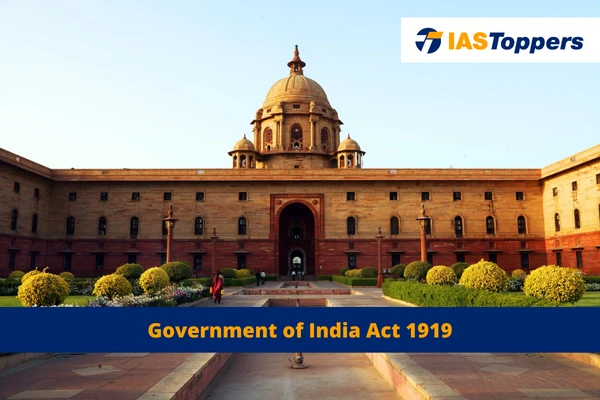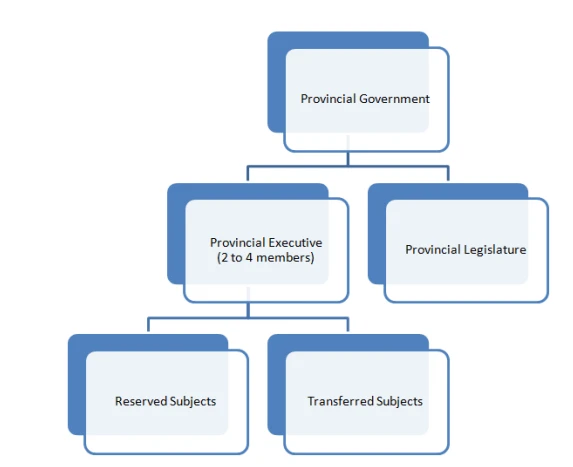Government of India Act 1919 was the Act of British Parliament to increase the involvement of Indians in the governance of their own nation India. In this article, you will learn definition, background, Government of India Act 1919 features, difference between Government of India act 1919 and 1935, Simon Commission, Communal Award, merits and demerits providing key insights for GS Paper-II Polity and Governance section of UPSC IAS Exam.
Table of Content
- What is Government of India Act 1919?
- Background of the Government of India Act 1919
- Principal features of Government of India Act 1919
- Simon Commission
- Communal Award
- Merits of Montagu Chelmsford reforms
- Shortcomings of Government of India Act 1919
- Difference between Government of India Act 1919 and Government of India Act 193
- Conclusion of Government of India Act 1919
- Frequently Asked Questions
What is Government of India Act 1919?
- The Government of India Act 1919 was the Act of British Parliament that aimed to enhance the involvement of Indians in the governance of their own nation.
Background of the Government of India Act 1919:
- On August 20, 1917, the British Government had made its first-ever declaration regarding its objective to gradually implement a responsible Government in India.
- This led to the enactment of the Government of India Act in 1919.
- The 1919 Government of India act became effective in 1921.
- The Government of India Act 1919 is also known as the Montagu-Chelmsford Reforms or Montford reforms 1919.
- This name was given after the Secretary of State for India Edwin Montagu, and the Viceroy of India, Lord Chelmsford.
- The Government of India Act 1919 was based upon the recommendations of a report by Montagu.
Principal features of Government of India Act 1919:
Central and provincial subjects:
- The Government of India Act 1919 clearly defined and separated the central and provincial subjects.
- This decreased the control of central government over the provinces.
- Both the central and provincial legislatures can enact laws pertaining to their respective subjects.
- However, the government structure remained centralized and unitary.
Provincial subjects:
- The Montagu Chelmsford reforms introduced a system called dyarchy in Provincial subjects.
- The term dyarchy was derived from the Greek word “diarche” meaning double rule.
- Dyarchy proved largely disastrous for the administration in long run.
- Under dyarchy the Provincial subjects were categorized into two parts: transferred and reserved.
- The transferred subjects included education, local government, health, excise, industry, public works, religious endowments, etc.
- The reserved subjects included law and order, irrigation, finance, land revenue, etc.
- The transferred subjects were to be administered by the Governor with the assistance of Ministers who were then accountable to the legislative council.
- In contrast, the reserved subjects were to be administered by the Governor and his executive council without being accountable to the legislative council.
- The Secretary of State and the Governor-General can interfere for the matters related to the reserved subjects but this interference cannot be performed seamlessly for the transferred subjects.
Bicameralism in Central legislature:
- The Montagu Chelmsford reforms had introduced bicameralism and direct elections for the first time in India.
- The Indian legislative council was replaced by a bicameral legislature consisting of-
- An Upper House known as the Council of State
- A Lower House known as the Legislative Assembly
- The majority of members of both the Houses were chosen through direct elections.
Provincial legislative assemblies:
- The size of the provincial legislative assemblies was increased.
- About 70% of the provincial legislative members has to be elected.
Viceroy’s executive council:
- It mandated that three out of the six members of the Viceroy’s executive council, excluding the Commander-in-Chief, should be Indian.
Voting mechanism:
- It established separate electorates for Sikhs, Indian Christians, Anglo-Indians, and Europeans.
- Thus, concept of separate electorates was expanded by the principle of communal representation.
- It granted suffrage to a limited number of individuals based on property ownership, tax payment, or educational qualifications.
High Commissioner for India:
- It established a new office of the High Commissioner for India in London.
- Some of the responsibilities performed by the Secretary of State for India were transferred to the High Commissioner for India.
Public service:
- It established a public service commission for the recruitment of civil servants.
- The public service commission lead to the establishment of the Central Public Service Commission in 1926.
Budgets:
- It introduced a separation between provincial budgets and the central budget.
- It authorized the provincial legislatures to formulate their own budgets.
- It included a provision for the appointment of a statutory commission to examine and report on the functioning of the Act after a period of ten years since its implementation.
- This led to the formation of the Simon Commission.
Simon Commission:
- In November 1927, the British Government had appointed a 7-member statutory commission under the chairmanship of Sir John Simon.
- The Simon commission’s objective was to assess the situation in India under the new Constitution.
- All commission members of Simon Commission were of British origin this resulted in Indian parties boycotting the commission.
- In 1930, the Simon commission presented its report which proposed:
- The abolition of dyarchy
- The expansion of responsible government in the provinces
- The creation of a federation comprising British India and princely states
- The continuation of communal electorates
- In response to these proposals, the British Government had organized 3 round table conferences with representatives from the British Government, British India, and Indian princely states.
- After these discussions, a “White Paper on Constitutional Reforms” was prepared and presented for consideration by a Joint Select Committee of the British Parliament.
- The recommendations from this committee were incorporated with certain modifications into the subsequent Government of India Act in 1935.
Communal Award:
- In August 1932, The British Prime Minister Ramsay MacDonald has introduced a plan called the Communal Award to address minority representation.
- The Communal Award had maintained separate electorates for various groups such as Muslims, Sikhs, Indian Christians, Anglo-Indians, and Europeans.
- The Communal Award had also extended this provision to the depressed classes or the Scheduled Castes.
- This extension to the depressed classes was criticised by Mahatma Gandhi, who in protest has organised a fast unto death at Yerawada Jail in Poona.
- A consensus agreement was reached between Congress leaders and representatives of the depressed classes– the Poona Pact.
- The Poona Pact upheld the Hindu joint electorate system while allocating reserved seats for the depressed classes.
Merits of Montagu Chelmsford reforms:
- The federal structure with slight control of Union government became basis of the Constitution of independent India.
- The changes allowed increased participation of Indians in the administration where some Indians hold important portfolios such as labour and health.
- It was the first time that the elections were introduced to the general public.
- This fostered a sense of political awareness among the people.
- Many Indian women were granted the right to vote for the first time.
- The Government of India Act 1919 shifted towards establishment of responsible government in India.
- The Government of India Act of 1919 also facilitated direct interaction between the Indians and the administration, providing a valuable experience that helped after India after independence.
Shortcomings of Government of India Act 1919:
- There was absence of accountable governance at the provincial level for the reserved subjects.
- The implementation of separate electorates for different communities led to further factionalism in India.
- The introduction of the dual system of diarchy in the provinces was one of the greatest failures of the Act.
- The act consolidated communal representation while limiting the franchise where only a few privileged can chose the representatives which excluded the common man.
- The Governor-General and Governors held considerable power to undermine the legislatures at the central and provincial levels, respectively.
- The allocation of seats in the central legislature was done on the basis of importance of the provinces as determined by the British.
- In 1919, the Rowlatt Acts was passed that imposed several restrictions on the press and freedom of movement.
- Despite the opposition from Indian members of the legislative council, Rowlatt Acts were approved.
- This led several members to resign in protest.
Difference between Government of India Act of 1919 and Government of India Act 1935:
| Aspect | Government of India Act of 1919 | Government of India Act 1935 |
| Dyarchy System | The Government of India act 1919 introduced dyarchy | Ended the system of dyarchy |
| Provincial Autonomy | Limited provincial autonomy | Provided major provincial autonomy |
| Responsible Government | Not introduced | Introduced responsible government in the provinces |
| Constitutionalism | Did not introduce federalism | Introduced federalism with the Federal, Provincial, and Concurrent Lists |
| Centralization | Emphasized centralization | Introduced the concept of “Federation of India” |
| Federation of India | Not applicable | A federation composed of British provinces and princely states |
| Franchise | No significant change in the franchise | Extended the franchise to about 10% of the population. Increased the franchise from 7 million to 35 million. |
Conclusion of Government of India Act 1919:
The objective of the Montagu Chelmsford reforms of 1919 was to increase the involvement of Indians in the governance and administration of India. The Act emphasized centralization, with limited provisions for local self-government. The Act failed to address the broader aspirations of the Indian people for self-governance and independence. The Act served as a precursor to the more comprehensive Government of India Act 1935.
Ref:Source-1
FAQs(Frequently Asked Questions)
What were the Montagu Chelmsford reforms?
The Montagu-Chelmsford Reforms was the Act of British Parliament that aimed to enhance the involvement of Indians in the governance of their own nation.
What was another name of Government of India act 1919?
The Government of India act 1919 was known as the Montagu-Chelmsford Reforms or Montford reforms 1919.
When was the Montagu Chelmsford reforms introduced?
The Montagu Chelmsford reforms were announced in the year 1919.
Why Montagu Chelmsford reforms were opposed?
Instead of the promised greater autonomy to governance of India, Montagu Chelmsford reforms brought more provisions for factionalism in India such as separate electorate.





